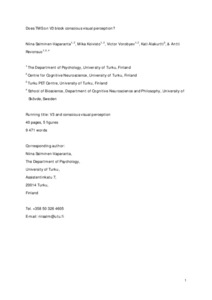Does TMS on V3 block conscious visual perception?
Antti Revonsuo; Mika Koivisto; Victor Vorobyev; Niina Salminen-Vaparanta; Kati Alakurtti
https://urn.fi/URN:NBN:fi-fe2021042718460
Tiivistelmä
Primary visual cortex (V1) and extrastriate
V2 are necessary for the emergence of visual consciousness, but the
effects of involvement of extrastriate V3 on visual consciousness is
unclear. The objective of this study was to examine the causal role of
V3 in visual consciousness in humans. We combined neuronavigated
transcranial magnetic stimulation (TMS) with a computational model of
the TMS-induced electric field to test whether or not the intact
processing of visual input in V3, like in V1 and V2, is necessary for
conscious visual perception.
We targeted the stimulation both to V2 and to V3. If TMS of V3 blocks
conscious visual perception of stimuli, then activation in V3 is a
causally necessary prerequisite for conscious perception of stimuli.
According to the alternative hypothesis, TMS of V3 will not block the
conscious visual perception of stimuli, because the pathways from V1 to
the higher cortical areas that go around V3 provide sufficient visual
input for the emergence of conscious visual perception. The results
showed that TMS interfered with conscious perception of features,
detection of stimulus presence and the ability to discriminate the
letter stimuli both when TMS was targeted either to V3 or to V2. For the
conscious detection of stimulus presence, the effect was significantly
stronger when V2 was stimulated than when V3 was stimulated. The results
of the present study suggest that in addition to the primary visual
cortex and V2, also V3 causally contributes to the generation of the
most basic form of visual consciousness. Importantly, the results also
indicate that V3 is necessary for visual perception in general, not only
for visual consciousness.
Kokoelmat
- Rinnakkaistallenteet [19207]
